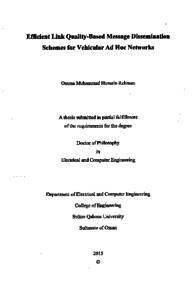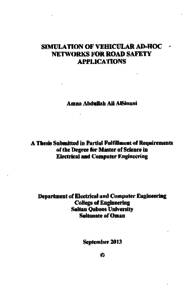Document
Efficient link quality-based message dissemination Schemes for vehicular ad hoc networks
Publisher
Sultan Qaboos University
Gregorian
2015
Language
English
English abstract
There has been growing research interests on vehicular ad hoc networks (VANETS) over the past years due to their ease of deployment and potential support for wide range of applications that can greatly enhance our everyday driving experience on the road. Multi-hop message dissemination is expected to be the primary mode of communication among vehicles for many VANET applications. High reachability and low end-to-end delays are among the key requirements of any dissemination scheme, especially when handling safety-related messages, which are inherently critical-in nature. Furthermore, any dissemination scheme should ensure efficient utilization of the channel bandwidth, a resource that is often scarce in VANETs. However, guaranteeing good performance levels in reachability, end-to-end delay as well as bandwidth utilization is a challenging issue in message dissemination over VANETS, which has not so far been adequately addressed in the literature. In an effort to fill this ap, this research investigates the above-described performance aspects of messagedissemination in VANETS, with a particular focus on improving message reachability over high node density networks. The first part of this research proposes a new message dissemination scheme for multi hop communication over a platoon of vehicles, referred to as Link Quality-Based Message Dissemination (LQMD). The LQMD scheme employs distributed and sender-oriented relay nodes selection mechanisms, where relay nodes are selected based on the estimated link qualities of the single-hop forward links between a given sender and its neighbouring nodes. The performance of two variants within the LQMD scheme, notably rigid and adaptive, is investigated over differing mobility scenarios, mainly reflecting low and high speed variations among vehicles. Our simulation results reveal that the proposed LQMD scheme improves messages reachability, especially over a highly dense network, compared to similar existing solutions, e.g. the most commonly adopted Furthest Distance (FD) scheme, while it still manages to maintain low end-to-end delays and high saved rebroadcasts. The second part of this research suggests a new class of hybrid relay nodes selection scheme that attempts to combine the best features of existing message dissemination schemes, including those exhibited by the FD and our above-mentioned LQMD scheme. The hybrid scheme takes into account the spatial distribution of neighbouring nodes to decide upon a particular "ordered" combinations of relay nodes. To the best of our knowledge, the present study is the first in literature to propose such a class of hybrid scheme. Our performance analysis presented in this thesis indicates that compared to the existing "conventional" versions, the new hybrid scheme improves reachability performance by up to 40%. Most existing research studies on VANETs, including ours, have assumed the Two Ray Ground reflection channel model. Although such a model has been widely used in most existing studies, it suffers from a number of shortcomings including its inability to capture the impact of signal fading. The third part of this research attempts to shed some light on the impact of more realistic propagation channel models on the performance of message dissemination schemes devised for VANETs. To this end, a comparative performance study of several schemes is carried out over both the Two Ray Ground and the Nakagami channel models. Our results show that while the hybrid schemes still exhibit superior performance in most circumstances, most dissemination schemes suffer from a noticeable performance degradation when the Nakagami fading channel model is used. This is because the hybrid scheme simultaneously takes into account the quick dissemination of messages to targeted destinations as well as the selection of relay nodes that exhibit high link qualities with the sender. Having said that, the performance degradation in the hybrid scheme is less accentuated compared to the adaptive LQMD and FD schemes. A plausible spectrum of applications that can be benefited from our proposed LQMD and hybrid schemes over VANETs include pre-emptive measures for enhancing road safety and traffic flow efficiency alongside with the provision of a variety of infotainment services. It is worth noting that in order to investigate the performance behaviour exhibited by the different message dissemination schemes examined by this research, a new performance measure is introduced, referred to as the "Relay Selection Optimality". This metric counts the number of cases where a given relay node has indeed successfully relayed the message. The introduced measure attempts to capture the ability of a given message dissemination scheme to make a "better" selection of the next-hop relay node among a group of contending nodes.
Description
Thesis
Member of
Resource URL
Arabic abstract
على مدى السنوات الماضية لوحظ إهتمامات بحثية متزايدة في شبكات الإتصال الخاصة ما بين المركبات (VANETs نظرا لسهولة النشر والدعم المحتمل لمجموعة واسعة من التطبيقات التي يمكن أن تعزز بشكل كبير من تجربة القيادة اليومية على الطريق من المتوقع أن تكون نشر رسالة المتعددة القفز هي الوسيلة الأساسية للتواصل بين المركبات للعديد من التطبيقات في VANETs. إستقبال الرسالة بنسبة عالية وإنخفاض التأخير في الإستقبال من نهاية إلى نهاية أخرى تعتبر من بين المتطلبات الرئيسية في أي مخطط نشر في VANETs وخاصة عند التعامل مع الرسائل المتعلقة بالسلامة المرورية، والتي تعتبر بالغة الأهمية بطبيعتها. علاوة على ذلك، فإن أي خطة النشر يجب أن تضمن الإستخدام الفعال لعرض النطاق الترددي لقناة الإتصال، التي غالبا ما ردا نادرا في VANETS. ومع ذلك فإن ضمان مستويات أداء جيدة في إستقبال الرسالة، التأخير في الإستقبال من نهاية إلى نهاية وكذلك في إستخدام عرض النطاق الترددي، مسألة صعبة في نشر الرسالة عبر VANETs، والتي لم ترى حتى الآن معالجة كافية في الأوراق العلمية المنشورة في محاولة لملء هذه الفجوة، يحقق هذا البحث جوانب الأداء المذكورة أعلاه لنشر رسالة في VANETs، مع التركيز بشكل خاص على تحسين إستقبال الرسالة عبر الشبكات العالية في كثافة العقدة. الجزء الأول من هذا البحث يقترح خطة نشر رسالة جديدة للإتصال المتعددة القفز على مجموعة من المركبات، ويشار إليه بإسم مخطط نشر رسالة القائم على جودة الرابط (LQMD). إن مخطط LQMD تستخدم آليات تتابع التوزيع و توجيه المرسل الإختيار الناقل، حيث يتم اختيار الناقل بناء على جودة الرابط بين مرسل معين والعقد المجاورة لها. تم التحقيق في أداء نوعين من ضمن مخطط LQMD، ولا سيما الجامدة والقابلة للتكيف، و على اختلاف سيناريوهات التنقل، مما يعكس بشكل رئيسي إلى تغيرات منخفضة وعالية في إختلاف السرعة ما بين السيارات. وتكشف نتائج المحاكاة لدينا أن المخطط المقترح LQMD يحسن في إستقبال الرسالة، وخاصة عبر الشبكات العالية في كثافة العقدة، بالمقارنة مع الحلول القائمة المماثلة، على سبيل المثال مخطط أعتمد الأكثر شيوعا و المعروفة بإسم الأبعد مسافة (FD)، في حين أنه لا يزال يدير الحفاظ على انخفاض التأخير في الإستقبال من نهاية إلى نهاية وعلو نسبة حفظ إعادة الإذاعة الجزء الثاني من هذا البحث يقترح نظام هجين لإختيار عقد الناقل الذي يحاول الجمع بين أفضل الميزات من مخططات النشر الموجودة، بما في ذلك تلك التي أظهرتها FD و LQMD المذكور أعلاه. نظام الهجين يأخذ في الاعتبار التوزيع المكاني للعقد المجاورة لإتخاذ القرار على وجه الخصوص لتكوين معين من العقد المتواجدة. إلى حد علمنا، هذه الدراسة هي الأولى من نوعها في الأوراق العلمية المنشورة التي تقترح مثل هذا النوع من نظام الهجين. بعد تحليل أدائنا المقدمة في هذه الأطروحة و مقارنته مع المخططات التقليدية، نظام الهجين الجديد يحسن أداء إستقبال الرسالة بنسبة تصل إلى 40%. تفترض معظم البحوث الدراسية القائمة على VANETs، بما فيه عملنا، نموذج قناة الإنعكاس الأرضي للشعاعين. بالرغم من أن هذا النموذج قد استخدمت على نطاق واسع في معظم الدراسات الموجودة، فإنه يعاني من عدد من أوجه القصور بما في ذلك عدم قدرتها على التقاط أثر عامل التلاشي في قناة الإتصال. ولهاذا فإن الجزء الثالث من هذا البحث يحاول إلقاء بعض الضوء على تأثير نماذج أكثر واقعية لقناة الإتصال على أداء مخططات نشر الرسالة في VANETs. تحقيقا لهذه الغاية، تم مقارنة الأداء لعدة مخططات على كل من النموذج لقناة الإنعكاس الأرضي للشعاعين و النموذج لقناة Nakagami دوعامل التلاشي في قناة الإتصال. نتائجنا تظهر أنه في حين أن نظام الهجين لا يزال يحمل الأداء المتفوق في معظم الحالات، فإن معظم مخططات النشر تعاني من تدهور ملحوظ في الأداء عند استخدام نموذج Nakagami. وذلك لأن نظام هجين يأخذ في الوقت نفسه بالاعتبار النشر سريع للرسائل إلى الوجهات المستهدفة وكذلك اختيار عقد الناقل ذو الروابط العالية الجودة مع المرسل. في حين قول هذا، تدهور الأداء في نظام الهجين هو أقل حدة بالمقارنة مع LQMD القابلة للتكيف و FD. نطاق التطبيقات التي يمكن الاستفادة من مخططات LQMD والهجين المقترحة على VANETs تتضمن، تدابیر وقائية لتعزيز السلامة على الطرق وكفاءة الحركة المرورية إلى جانب تقديم مجموعة متنوعة من الخدمات الإعلامية بالرسالة. ومن الجدير بالذكر أنه من أجل التحقيق في سلوك الأداء التي أظهرتها مختلف مخططات نشر الرسالة التي تم فحصها من قبل هذا البحث، فإن هذا البحث يعرض مقياسا جديدا للأداء، ويشار إليه بإسم "مثالية إختيار الناقل". هذا المقياس يحسب عدد الحالات التي نقلت الرسالة عن طريق ناقل معین بنجاح حيث يحاول المقياس الجديد معرفة قدرة خطة نشر الرسالة إلى اختيار أفضل عقدة من ضمن مجموعة من العقد المتنازعة
Category
Theses and Dissertations


